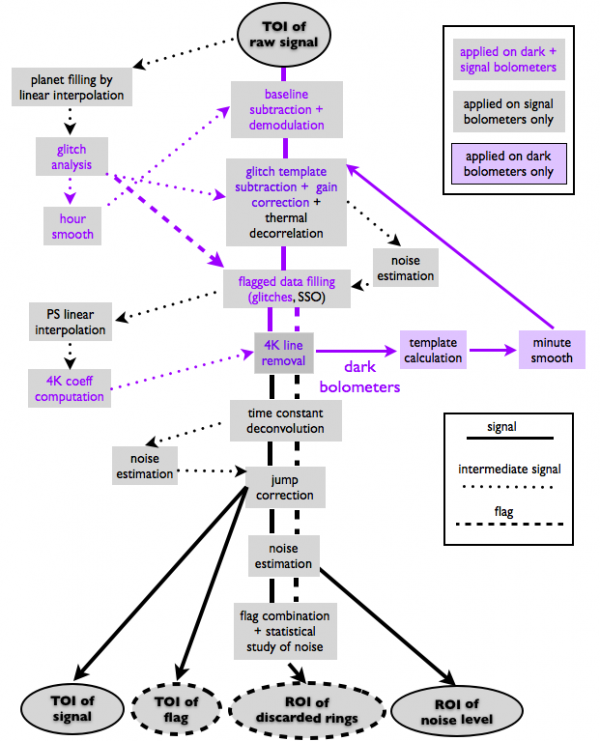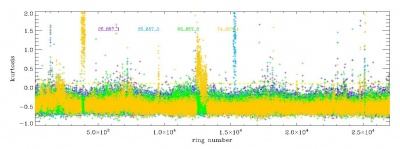Difference between revisions of "TOI processing"
| Line 38: | Line 38: | ||
[[File:HFI_4_4_2_RTSexample13.jpg|thumb|400px|Example of RTS detection]] | [[File:HFI_4_4_2_RTSexample13.jpg|thumb|400px|Example of RTS detection]] | ||
| + | |||
| + | |||
| + | [[Category:Data processing]] | ||
Revision as of 16:04, 5 October 2012
This Section kept with a low profile as this Planck release does not contain TOIs.
Contents
Overview[edit]
We describe here the how the TOIs are processed in order to be used for map production. We do not repeat the general features of the pipeline which are given in the HFI Data Processing article (REF). Here we give complementary explanations on some details. The TOI of each bolometer is processed independently of the other bolometers, so as to keep the noise properties as uncorrelated as possible. The processing involves modifying the TOI itself for what concerns the conversion to absorbed power and the correction of glitch tails. It also adds a flag TOI that masks the TOI samples that are not to be projected on maps for various reasons.
Input TOI[edit]
The input TOI consists in the AC modulated voltage output of the readout of each bolometer. The input has previously been decompressed, and converted from internal digital units to voltage via a constant factor. The TOI has a regular sampling at the acquisition frequency of facq=180.373700+-0.000050 Hz. There are almost no missing data in the TOIs, except for few hundred samples of 545 and 857GHz TOIs which are lost in the on-board compression due to saturation on the Galactic Center crossings.
General Pipeline Structure[edit]
The next figure shows how the initial ccTOI is transformed and how flags are produced:
Output TOIs and products[edit]
A TOI of clean calibrated samples (ccTOI) and a combined flag TOI (fTOI) are the outputs of the processing. The ccTOI is calibrated so as to represent the instantaneous power absorbed by the detector. It is worth mentioning how the ccTOI is changed with respect to the input TOI, beyond the harmless constant conversion factor from voltage to absorbed power. The demodulation stage allows to get the demodulated bolometer voltage. The non-linearity correction is a second-order polynomial correction based on the physical but static bolometer model. In order to avoid too much masking after glitches, a glitch tail is subtracted after an occurrence of a glitch in the TOI. Finally, the temporal response of the bolometer is deconvolved. This affects mostly the high-temporal frequency part of the TOI, although a small but significant low frequency tail is corrected too. Although flagged samples are not projected, their value influences the valid samples somehow. Hence interpolation procedures introduce some indirect modifications of the TOI. The flag TOI is a combination a dozen flags with an OR logic. Only unflagged data are projected. The exhaustive list of flags is given here: CompressionError, NoData, SSO, UnstablePointing, Glitch, BoloPlateFluctuation, RTS, Jump, PSBab. A complete qualification of the data is obtained at the ring level. If the TOI shows an anomalous behaviour during the duration of a ring, this ring is discarded from projection.
Trends in the output processing variables[edit]
Here we intend to show the trend of the systematic effects that are dealt with in the TOI processing
Glitch statistics[edit]
4K cooler lines variability[edit]
Noise stationarity[edit]
Noise power spectrum
rms per ring
(Planck) High Frequency Instrument
Solar System Object
random telegraphic signal

